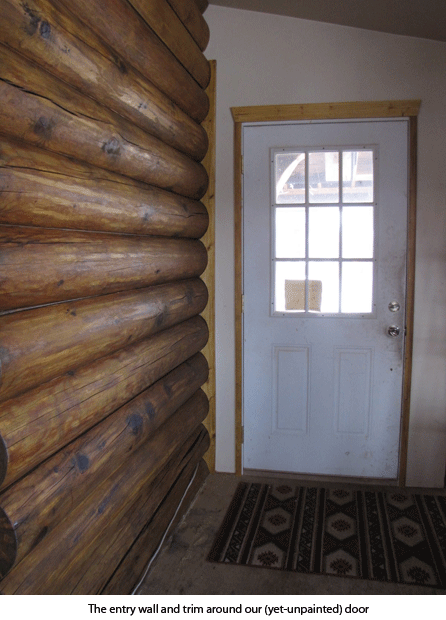With snow melting outdoors and little pepper plants happily growing in our greenhouse, we’re trying to finish up a few indoor projects because we probably won’t be getting at them, come warm weather. Will got the log wall sanded in the new addition, so I climbed up on my trusty ladder and stained the whole works. I do not like ladders! But the look is great. Today, he’s finishing putting up the last of the trim around the doors. It looks so good! Now I only have to paint the front door, stain the laundry room door, and… It never really is done, is it? But I’m totally happy with the progress we’ve already made.
Canning cauliflower
Can I can cauliflower? If so, please give me instructions.
Brenda Presson
Rector, Arkansas
Place cauliflower in a large pot and cover with boiling water. Simmer for 3 minutes. Drain. Pack hot, into hot jars, leaving 1 inch of headspace. Add 1/2 tsp. salt to each pint and 1 tsp. to each quart, if desired. Pour boiling water over cauliflower, leaving 1 inch of headspace. Remove air bubbles. Wipe rim of jar clean; place hot, previously-simmered lid on jar and screw down ring firmly tight. Process pints for 30 minutes and quarts for 35 minutes at 10 pounds pressure. — Jackie
Potting soil
What kind or brand of potting soil do you use?
Richard Burns
Keyser, West Virginia
I use Pro Mix, which is available through our local greenhouse. I just buy ahead a couple of large sacks. It contains peat, perlite, and vermiculite and is finely milled. I use this for seed starting and planting my transplants. I fill my hanging baskets with a mix of this and a cheaper potting soil, along with our own compost. — Jackie
Shelf life of herbs
What is the shelf life of dry-packed mixed herbs in jars?
Teresa Moye
Fayetteville, Georgia
Practically forever. Chefs, of course, will disagree with me, saying that old herbs lose their flavor after about a year. I really haven’t seen that to be a problem with homestead cooking. I taste my recipes as they cook and if they seem to need more herbs, I just add ’em. — Jackie
Recipe for beenie-weenies
Do you have a recipe for beenie-weenies?
D. Kaufman
Seymour, Missouri
You can make your own beenie-weenie substitute by slicing good quality hotdogs and mixing them in with your own baked bean recipe, then canning the mixture just like you would baked beans with ham or bacon. You should process pints for 80 minutes and quarts for 95 minutes at 10 pounds pressure. You process them longer than a meat product because they tend to be a thicker product, because of the beans and because they contain meat. — Jackie
Storing granola
I make granola in bulk and prefer not to rely on the freezer for long-time storage. Do you think canning it would help keep the oil taking on a rancid flavor as it is kept in the basement? Could I fill jars with finished granola, put them in the oven for awhile and put lids on as they are removed to let them seal as they cool?
Jo MacDonald
Mount Horeb, Wisconsin
Sorry, but this is something that won’t can. No, putting them in the oven won’t dependably seal or process the food. — Jackie
Canning ham
I am thinking of buying extra hams when they are on sale for Easter. I like the bone-in type. I was wondering if you can slice it and can it somehow for later use rather than freeze. I know you can can bacon but don’t know how to can ham.
Jackie Schillinger
Pleasantville, Pennsylvania
I often pick up several on-sale hams around Easter to can. It cans up great and is very handy for quick meals; much faster than thawing out frozen ham. And no possibility of freezer burn, either. I can my ham mostly in pints and half-pints. The half-pints contain smaller dices that I use in casseroles, quiches, and other mixed dishes. The pints contain larger slices and pieces to use as a main dish ingredient. You can also can larger ham slices, which you can later bake or fry, as you wish. Process your ham just like any beef or pork, covering it with boiling broth and processing pints for 75 minutes and quarts for 90 minutes at 10 pounds pressure. (If you live at an altitude above 1,000 feet, consult your canning book for directions on increasing your pressure, if necessary.) Good canning! — Jackie
Feeding chickens
I’ve been following the conversation about how to feed chickens less expensively in the winter. Love the idea of feeding hay (never even thought of that) to our flock; we will definitely try that. I’ve also read suggestions to add worms to the girl’s winter diet for a protein supplement. The article I read suggested a grow-your-own worm bin which has the added benefits of composting some garbage and giving you worm casings for the garden. I was wondering if you have experience with worm bins and could offer any advice?
Brenda Palmer
Marblemount, Washington
I have raised worms indoors, as fishing bait, although you could sure feed the larger ones that are “extras,” to your chickens. My worm bin was 12 inches deep and 2×2-feet, made of boards with a plywood bottom. I drilled a few 1/2-inch holes in the bottom for drainage and covered them with screen before filling the box. I filled my box with a mixture of garden compost and sphagnum moss. The worms I grew were just plain red worms from a bait shop. I kept the box in my basement for years and the worms did great. I fed them a mixture of food scraps, coffee grounds, and a little cornmeal, scratched into the top of the soil. When I wanted worms, I just carefully dug into the box with a trowel and harvested what I needed. When we moved, I freed my worms in the garden.
Although chickens routinely eat worms outside, it is possible, although not probable, that they may pick up parasites, such as tapeworm, from them. I’ve never seen it a problem, but it is possible. — Jackie






My grandfather had a chest type freezer buried at the edge of his garden with about three inches and the door above ground only. He kept it filled with dirt and some of his garden scraps. He kept worms in there and when we wanted to go fishing we never wanted for bait. He had drilled out the latch so noone could get trapped in it. Although filled with dirt, I didn’t see how we could have.
Another way to have worms is to put like a goats watering trough under rabbit cages, if you raise rabbits. The poo and the kibbles that fall through the cage floor will fall into the troughs, giving the worms plenty of food to ingest.
You need to keep moisture in both of these containers, just not overly so.
You would get plenty of worm casings from either of these for your flower beds.
Jackie,
Just wanted to thank you for your encouragement to can meat. I was hestitant, but after putting up 5 lbs of boneless chicken in broth I felt very good about my work.
A week later (just to check ;) we opened a jar and had the best chicken noodle soup ever for dinner! My family was a bit surprised that the freshly opened jar of meat smelled like “real” cans of chicken soup from the store.
The rest of my jars are sitting there nicely, ready and waiting in my pantry!
I thought it only right to send you a great big thank you for your help!
Cheryl in Bakersfield, CA
Looks wonderful Jackie and Will! Hooray spring is finally getting here!
It looks great so far. I love the look of natural wood with stain on it. There’s nothing better.
It looks really great Jackie!
Comments are closed.